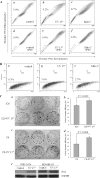Stem-like cancer cells are inducible by increasing genomic instability in cancer cells
- PMID: 20007324
- PMCID: PMC2836097
- DOI: 10.1074/jbc.M109.048397
Stem-like cancer cells are inducible by increasing genomic instability in cancer cells
Abstract
The existence of cancer stem cells (CSCs) or stem-like cancer cells (SLCCs) is regarded as the cause of tumor formation and recurrence. However, the origin of such cells remains controversial with two competing hypotheses: CSCs are either transformed from tissue adult stem cells or dedifferentiated from transformed progenitor cells. Compelling evidence has determined the chromosomal aneuploidy to be one of the hallmarks of cancer cells, indicating genome instability plays an important role in tumorigenesis, for which CSCs are believed to be the initiator. To gain direct evidence that genomic instability is involved in the induction of SLCCs, we utilized multiple approaches to enhance genomic instability and monitored the percentage of SLCC in cultured cancer cells. Using side population (SP) cells as a marker for SLCC in human nasopharyngeal carcinoma (NPC) and CD133 for human neuroblastoma cells, we found that DNA damage inducers, UV and mitomycin C were capable of increasing SP cells in NPC CNE-2 and neuroblastoma SKN-SH cells. Likewise, either overexpression of a key regulator of cell cycle, Mad2, or knock down of Aurora B, an important kinase in mitosis, or Cdh1, a key E3 ligase in cell cycle, resulted in a significant increase of SP cells in CNE-2. More interestingly, enrichment of SP cells was observed in recurrent tumor tissues as compared with the primary tumor in the same NPC patients. Our study thus suggested that, beside transformation of tissue stem cells leading to CSC generation, genomic instability could be another potential mechanism resulting in SLCC formation, especially at tumor recurrence stage.
Figures







Similar articles
-
Prognostic value of the stem cell markers CD133 and ABCG2 expression in esophageal squamous cell carcinoma.Dis Esophagus. 2012 Sep-Oct;25(7):638-44. doi: 10.1111/j.1442-2050.2011.01298.x. Epub 2012 Jan 11. Dis Esophagus. 2012. PMID: 22236447
-
Highly tumorigenic lung cancer CD133+ cells display stem-like features and are spared by cisplatin treatment.Proc Natl Acad Sci U S A. 2009 Sep 22;106(38):16281-6. doi: 10.1073/pnas.0905653106. Epub 2009 Sep 10. Proc Natl Acad Sci U S A. 2009. PMID: 19805294 Free PMC article.
-
Biologic characteristics of the side population of human small cell lung cancer cell line H446.Chin J Cancer. 2010 Mar;29(3):254-60. doi: 10.5732/cjc.009.10330. Chin J Cancer. 2010. PMID: 20193106
-
Multidrug resistance and cancer stem cells in neuroblastoma and hepatoblastoma.Int J Mol Sci. 2013 Dec 18;14(12):24706-25. doi: 10.3390/ijms141224706. Int J Mol Sci. 2013. PMID: 24351843 Free PMC article. Review.
-
Cancer stem cells: lessons from melanoma.Stem Cell Rev Rep. 2009 Mar;5(1):61-5. doi: 10.1007/s12015-008-9048-7. Epub 2008 Dec 18. Stem Cell Rev Rep. 2009. PMID: 19093230 Review.
Cited by
-
Tumor growth and metastasis can be inhibited by maintaining genomic stability in cancer cells.Front Med. 2015 Mar;9(1):57-62. doi: 10.1007/s11684-015-0389-8. Epub 2015 Feb 7. Front Med. 2015. PMID: 25663061
-
Case report: dermatomyositis associated with lung cancer with heterogeneous morphology.J Thorac Dis. 2017 Dec;9(12):E1110-E1117. doi: 10.21037/jtd.2017.11.107. J Thorac Dis. 2017. PMID: 29312776 Free PMC article.
-
Mechanisms involved in selecting and maintaining neuroblastoma cancer stem cell populations, and perspectives for therapeutic targeting.World J Stem Cells. 2021 Jul 26;13(7):685-736. doi: 10.4252/wjsc.v13.i7.685. World J Stem Cells. 2021. PMID: 34367474 Free PMC article. Review.
-
Centrosome loss or amplification does not dramatically perturb global gene expression in Drosophila.Biol Open. 2012 Oct 15;1(10):983-93. doi: 10.1242/bio.20122238. Epub 2012 Aug 17. Biol Open. 2012. PMID: 23213376 Free PMC article.
-
Baicalin hydrate inhibits cancer progression in nasopharyngeal carcinoma by affecting genome instability and splicing.Oncotarget. 2017 Dec 4;9(1):901-914. doi: 10.18632/oncotarget.22868. eCollection 2018 Jan 2. Oncotarget. 2017. PMID: 29416665 Free PMC article.
References
-
- Reya T., Morrison S. J., Clarke M. F., Weissman I. L. (2001) Nature 414, 105–111 - PubMed
-
- Bapat S. A. (2007) Semin. Cancer Biol. 17, 204–213 - PubMed
-
- Houghton J., Morozov A., Smirnova I., Wang T. C. (2007) Semin. Cancer Biol. 17, 191–203 - PubMed
-
- Huntly B. J., Gilliland D. G. (2005) Nat. Rev. Cancer 5, 311–321 - PubMed
Publication types
MeSH terms
Substances
LinkOut - more resources
Full Text Sources
Research Materials
Miscellaneous

